Fault-Block Platform Evolution between Late Cretaceous and Early Miocene along the Margin of the Latium-Abruzzi Carbonate Platform (Southern Prenestini Mountains, Central Apennines, Italy)
Abstract
:1. Introduction
2. Geological Setting
3. Methods
4. Results
5. Discussion
6. Conclusions
Author Contributions
Funding
Acknowledgments
Conflicts of Interest
References
- Tucker, M.E.; Wright, V.P. Carbonate Sedimentology; Blackwells Scientific: Hoboken, NJ, USA, 1990. [Google Scholar]
- Handford, C.R.; Loucks, R.G. Carbonate depositional sequences and systems tracts—Responses of carbonate platforms to relative sea-level changes: Chapter 1. In Carbonate Sequence Stratigraphy: Recent Developments and Applications; AAPG Special Volume; American Association of Petroleum Geologists: Tulsa, OK, USA, 1993; pp. 3–41. [Google Scholar]
- Pomar, L. Types of carbonate platforms: A genetic approach. Basin Res. 2001, 13, 313–334. [Google Scholar] [CrossRef]
- Bosence, D. A genetic classification of carbonate platforms based on their basinal and tectonic settings in the Cenozoic. Sediment. Geol. 2005, 175, 49–72. [Google Scholar] [CrossRef]
- Schlager, W. Benthic carbonate factories of the Phanerozoic. Int. J. Earth Sci. 2003, 92, 445–464. [Google Scholar] [CrossRef]
- Pomar, L.; Hallock, P. Carbonate factories: A conundrum in sedimentary geology. Earth-Sci. Rev. 2008, 87, 134–169. [Google Scholar] [CrossRef]
- Pomar, L. Carbonate systems. In Regional Geology and Tectonics, 2nd ed.; Scarselli, N., Adam, J., Chiarella, D., Roberts, D.G., Bally, A.W., Eds.; Elsevier: Amsterdam, The Netherlands, 2020; pp. 235–311. [Google Scholar]
- Schlager, W. Carbonate sedimentology and sequence stratigraphy. In Concept for Sedimentology and Paleontology; Corsey, L.J., Ed.; SEPM (Society for Sedimentary Geology) Special Publications: Tulsa, OK, USA, 2005; Volume 8. [Google Scholar]
- Hallock, P. Changing influences between life and limestones in earth history. In Coral Reefs in the Anthropocene; Springer: Dordrecht, The Netherlands, 2015; pp. 17–42. [Google Scholar]
- Adams, C.G.; Lee, D.E.; Rosen, B.R. Conflicting isotopic and biotic evidence for tropical sea-surface temperatures during the Tertiary. Palaeogeogr. Palaeoclimatol. Palaeoecol. 1990, 77, 289–313. [Google Scholar] [CrossRef]
- Pomar, L.; Baceta, J.I.; Hallock, P.; Mateu-Vicens, G.; Basso, D. Reef building and carbonate production modes in the west-central Tethys during the Cenozoic. Mar. Pet. Geol. 2017, 83, 261–304. [Google Scholar] [CrossRef]
- Hallock, P.; Seddighi, M. Why did some larger benthic foraminifera become so large and flat? Sedimentology 2022, 69, 74–87. [Google Scholar] [CrossRef]
- Brasier, M.D. An outline history of seagrass communities. Palaeontology 1975, 18, 681–702. [Google Scholar]
- Ivany, L.C.; Portell, R.W.; Jones, D.S. Animal-plant relationships and paleobiogeography of an Eocene seagrass community from Florida. Palaios 1990, 3, 244–258. [Google Scholar] [CrossRef]
- Ćosović, V.; Drobne, K.; Moro, A. Paleoenvironmental model for Eocene foraminiferal limestones of the Adriatic carbonate platform (Istrian Peninsula). Facies 2004, 50, 61–75. [Google Scholar] [CrossRef]
- Mateu-Vicens, G.; Pomar, L.; Tropeano, M. Architectural complexity of a carbonate transgressive systems tract induced by basement physiography. Sedimentology 2008, 55, 1815–1848. [Google Scholar] [CrossRef]
- Brandano, M.; Frezza, V.; Tomassetti, L.; Pedley, M.; Matteucci, R. Facies analysis and palaeoenvironmental interpretation of the late Oligocene Attard Member (lower Coralline Limestone Formation), Malta. Sedimentology 2009, 56, 1138–1158. [Google Scholar] [CrossRef]
- Brandano, M.; Pomar, L.; Mateu-Vicens, G.; Cuffaro, M.; Gaglianone, G.; Petricca, P.; Stagno, V. Response: Commentary: Evaluating the role of seagrass in Cenozoic CO2 variations. Front. Environ. Sci. 2017, 5, 74. [Google Scholar] [CrossRef]
- Brandano, M.; Tomassetti, L.; Mateu-Vicens, G.; Gaglianone, G. The seagrass skeletal assemblage from modern to fossil and from tropical to temperate: Insight from Maldivian and Mediterranean examples. Sedimentology 2019, 66, 2268–2296. [Google Scholar] [CrossRef]
- Riordan, N.K.; James, N.P.; Bone, Y. Oligo–Miocene seagrass-influenced carbonate sedimentation along a temperate marine palaeoarchipelago, Padthaway Ridge, South Australia. Sedimentology 2012, 59, 393–418. [Google Scholar] [CrossRef]
- Braga, J.C.; Martín, J.M.; Aguirre, J.; Baird, C.D.; Grunnaleite, I.; Jensen, N.B.; Puga-Bernabéu, A.; Saelen, G.; Talbot, M.R. Middle-Miocene (Serravallian) temperate carbonates in a seaway connecting the Atlantic Ocean and the Mediterranean Sea (North Betic Strait, S Spain). Sediment. Geol. 2010, 225, 19–33. [Google Scholar] [CrossRef]
- Braga, J.C. Neogene rhodoliths in the Mediterranean basins. In Rhodolith/Maërl Beds: A Global Perspective; Springer: Cham, Switzerland, 2017; pp. 169–193. [Google Scholar]
- Brandano, M. Oligocene Rhodolith beds in the Central Mediterranean area. In Rhodolith/Maërl Beds: A Global Perspective; Springer: Cham, Switzerland, 2017; pp. 195–219. [Google Scholar]
- Bathurst, R.G.C. Carbonate Sediments and their Diagenesis, 2nd ed.; Elsevier: Amsterdam, The Netherlands, 1975. [Google Scholar]
- James, N.P.; Bone, Y.; Von Der Broch, C.C.; Gostin, V.A. Modern carbonate and terrigenous clastic sediments on a cool water, high energy, mid-latitude shelf: Lacepede, southern Australia. Sedimentology 1992, 39, 877–903. [Google Scholar] [CrossRef]
- Mutti, M.; Bernoulli, D.; Eberli, G.P.; Vecsei, A. Depositional geometries and facies associations in an Upper Cretaceous prograding carbonate platform margin (Orfento Supersequence, Maiella, Italy). J. Sediment. Res. 1996, 66, 749–765. [Google Scholar]
- Brandano, M. Unravelling the origin of a Paleogene unconformity in the Latium-Abruzzi carbonate succession: A shaved platform. Palaeogeogr. Palaeoclimatol. Palaeoecol. 2017, 485, 687–696. [Google Scholar] [CrossRef]
- Parotto, M.; Praturlon, A. Structural Model of Italy: Geological summary of the central Appennines. CNR Quad. De La Ric. Sci. 1975, 90, 257–331. [Google Scholar]
- Bernoulli, D. Mesozoic-Tertiary carbonate platforms, slopes and basins of the external Apennines and Sicily. In Anatomy of an Orogen: The Apennines and Adjacent Mediterranean Basins; Springer: Dordrecht, Switzerland, 2001; pp. 307–325. [Google Scholar]
- Civitelli, G.; Corda, L.; Mariotti, G. Il Bacino Sabino: 3 Evoluzione sedimentaria ed inquadramento regionale dall’Oligocene al Serravalliano. Mem. Soc. Geol. Ital. 1986, 35, 399–406. [Google Scholar]
- Cosentino, D.; Parotto, M. Assetto strutturale dei Monti Lucretili settentrionali (Sabina): Nuovi dati e schema tettonico preliminare. Geol. Romana 1986, 25, 73–90. [Google Scholar]
- Corrado, S. Nuovi vincoli geometrico-cinematici all’evoluzione neogenica del tratto meridionale della linea Olevano-Antrodoco. Boll. Della Soc. Geol. Ital. 1995, 114, 245–276. [Google Scholar]
- Bollati, A.; Corrado, S.; Marino, M. Inheritance of Jurassic rifted margin architecture into the Apennines Neogene mountain building: A case history from the Lucretili Mts (Latium, Central Italy). Int. J. Earth Sci. 2012, 101, 1011–1031. [Google Scholar] [CrossRef]
- Civitelli, G.; Brandano, M. Atlante delle litofacies e modello deposizionale dei Calcari a Briozoi e Litotamni nella Piattaforma carbonatica laziale-abruzzese. Boll. Soc. Geol. Ital. 2005, 124, 611–643. [Google Scholar]
- Giordano, G.; Mattei, M.; Funiciello, R. Geological map of the Colli Albani Volcano 1:50,000. In The Colli Albani Volcano; Funiciello, R., Giordano, G., Eds.; Special publication of IAVCEI 2010; The Geological Society of London: London, UK, 2010. [Google Scholar]
- Doglioni, C. A proposal for the kinematic modelling of W-dipping subductions; possible applications to the Tyrrhenian-Apennines system. Terra Nova 1991, 3, 423–434. [Google Scholar] [CrossRef]
- Lustrino, M.; Morra, V.; Fedele, L.; Franciosi, L. Beginning of the Apennine subduction system in central western Mediterranean: Constraints from Cenozoic “orogenic” magmatic activity of Sardinia, Italy. Tectonics 2009, 28, 18762. [Google Scholar] [CrossRef]
- Carminati, E.; Lustrino, M.; Cuffaro, M.; Doglioni, C. Tectonics, magmatism and geodynamics of Italy: What we know and what we imagine. J. Virtual Explor. 2010, 36, 10–3809. [Google Scholar] [CrossRef]
- Gueguen, E.; Doglioni, C.; Fernandez, M. On the post-25 Ma geodynamic evolution of the western Mediterranean. Tectonophysics 1998, 298, 259–269. [Google Scholar] [CrossRef]
- Parotto, M.; Praturlon, A. The southern Apennine arc. In Special Volume of the Italian Geological Society for the IGC 32 Florence-2004; Società Geologica Italiana: Roma, Italy, 2004; Volume 32, pp. 33–58. [Google Scholar]
- Accordi, B.; Devoto, G.; La Monica, G.B.; Praturlon, A.; Sirna, G.; Zalaffi, M. Il Neogene nell’Appennino laziale-abruzzese. Commitee Mediterranean Neogene Stratigraphy, Proc. IV Session, Bologna. Giorn. Geol. 1967, 35, 235–268. [Google Scholar]
- Damiani, A.V.; Molinari, V.; Pichezzi, R.M.; Panseri, C.; Giovagnoli, M.C. Il passaggio Cretaceo-Terziario nei sedimenti carbonatici di piattaforma dei Monti Affilani (Lazio). Mem. Descr. Carta Geol. It. 1990, 38, 21–37. [Google Scholar]
- Cipollari, P.; Cosentino, D. Miocene unconformities in the Central Apennines: Geodynamic significance and sedimentary basin evolution. Tectonophysics 1995, 252, 375–389. [Google Scholar] [CrossRef]
- Carboni, M.G.; Civitelli, G.; Corda, L.; Esu, D.; Matteucci, R.; Pallini, G. Sedimenti spongolitici del Miocene inferiore e medio dell’Appennino centrale―Un inquadramento preliminare. Geol. Romana 1982, 21, 529–544. [Google Scholar]
- Brandano, M.; Lustrino, M.; Cornacchia, I.; Sprovieri, M. Global and regional factors responsible for the drowning of the Central Apennine Chattian carbonate platforms. Geol. J. 2015, 50, 575–591. [Google Scholar] [CrossRef]
- Civitelli, G.; Corda, L.; Mariotti, G. Il Bacino Sabino: 2 Sedimentologia e stratigrafia della serie calcarea e marnoso-spongolitica (Paleogene-Miocene). Mem. Soc. Geol. Ital. 1986, 35, 33–47. [Google Scholar]
- Brandano, M.; Cornacchia, I.; Catanzariti, R.; Tomassetti, L. The Monterey Event in the Mediterranean platform to basin transition: The Guadagnolo Formation (Miocene, Prenestini Mountains, Central Apennines). Palaeogeogr. Palaeoclimatol. Palaeoecol. 2021, 564, 110177. [Google Scholar] [CrossRef]
- Brandano, M.; Corda, L.; Mariotti, G. Orbital forcing recorded in subtidal cycles from a Lower Miocene siliciclastic–carbonate ramp system (Central Italy). Terra Nova 2005, 17, 434–441. [Google Scholar] [CrossRef]
- Carboni, M.G.; Di Bella, L.; Matteucci, R.; Palagi, I.M. La Serra—La successione spongolitica (Burdigaliano-Langhiano). In Proceedings of the Fifth Symposium on Ecology and Paleoecology of Benthic Communities, Paleobenthos V, Rome, Italy, 28–30 September 1992; pp. 46–50. [Google Scholar]
- Cipollari, P.; Cosentino, D. La linea Olevano-Antrodoco: Contributo della biostratigrafia alla sua caratterizzazione cinematica. Studi Geol. Camerti 1991, 4, 143–149. [Google Scholar]
- Praturlon, A.; Madonna, S. Mesozoic-Tertiary platforms in marginal areas (Mts Prenestini, Central Apennines). In Mapping Geology in Italy; Pasquarè, G., Venturini, C., Eds.; APAT: Avila Beach, CA, USA, 2004; pp. 167–176. [Google Scholar]
- Carbone, F.; Praturlon, A.; Sirna, G. The Cenomanian shelf-edge facies of Rocca di Cave (Prenestini Mts, Latium). Geol. Romana 1971, 10, 131–198. [Google Scholar]
- Carbone, F.; Sirna, G. Upper Cretaceous reef models from Rocca di Cave and adjacent areas in Latium Central Italy. In European Fossil Reef Models; Toomey, D.F., Ed.; SEPM Special Pubblication: Tulsa, OK, USA, 1981; Volume 30, pp. 427–445. [Google Scholar]
- Corda, L.; Madonna, S.; Mariotti, G. Late Cretaceous to early Miocene evolution of the Southern Prenestini Mountains (Central Apennines): From fault-block platforms to carbonate ramp. J. Mediterr. Earth Sci. 2020, 12, 15–31. [Google Scholar]
- Bollati, A.; Corrado, S.; Cosentino, D.; Marino, M.; Mattei, M.; Parotto, M. Assetto strutturale della catena a pieghe e sovrascorrimenti Umbro-Sabina (Italia Centrale) derivato dal rilevamento dei fogli 366 “Palombara Sabina” e 375 ”Tivoli” (Progetto CARG). Rend. Online Della Soc. Geol. Ital. 2011, 14, 37–61. [Google Scholar]
- Tavani, S.; Vignaroli, G.; Parente, M. Transverse versus longitudinal extension in the foredeep-peripheral bulge system: Role of Cretaceous structural inheritances during early Miocene extensional faulting in inner central Apennines belt. Tectonics 2015, 34, 1412–1430. [Google Scholar] [CrossRef]
- Danese, E.; Mattei, M. Sheet n. 375 “Tivoli” of the Geological Map of Italy to the 1:50,000 scale with Explanatory Notes (Foglio n. 385 “Albano Laziale” della Carta Geologica d’Italia alla scale 1:50,000 scale con note illustrative), ISPRA—Italian Geological Survey. In Calcareous Nannofossil Biostratigraphy; Bown, P.R., Ed.; British Micropalaeontology Society Publication Series; Kluwer Academic Publishers: Dordrecht, Switzerland, 1998; pp. 16–28. [Google Scholar]
- Mateu-Vicens, G.; Hallock, P.; Brandano, M.; Demchuk, T.; Gary, A. Test shape variability of Amphistegina d’Orbigny 1826 as a paleobathymetric proxy: Application to two Miocene examples. Geologic problems solving with microfossils. SEPM Spec. Publ. 2009, 93, 67–82. [Google Scholar]
- Beavington-Penney, S.J. Analysis of the effects of abrasion on the test of Palaeonummulites venosus: Implications for the origin of nummulithoclastic sediments. Palaios 1994, 19, 143–155. [Google Scholar] [CrossRef]
- Burchette, T.P.; Wright, V.P. Carbonate ramp depositional systems. Sediment. Geol. 1998, 79, 3–57. [Google Scholar] [CrossRef]
- Bosence, D.; Cross, N.; Hardy, S. Architecture and depositional sequences of Tertiary fault-block carbonate platforms; an analysis from outcrop (Miocene, Gulf of Suez) and computer modelling. Mar. Pet. Geol. 1998, 15, 203–221. [Google Scholar] [CrossRef]
- Wilson, M.E.; Bosence, D.W.; Limbong, A. Tertiary syntectonic carbonate platform development in Indonesia. Sedimentology 2000, 47, 395–419. [Google Scholar] [CrossRef]
- Sowerbutts, A. Sedimentation and volcanism linked to multiphase rifting in an Oligo-Miocene intra-arc basin, Anglona, Sardinia. Geol. Mag. 2000, 137, 395–418. [Google Scholar] [CrossRef]
- Benisek, M.F.; Marcano, G.; Betzler, C.; Mutti, M. Facies and stratigraphic architecture of a Miocene warm-temperate to tropical fault-block carbonate platform, Sardinia (Central Mediterranean Sea). Carbonate Systems During the Oligocene-Miocene Climatic Transition. Int. Assoc. Sedimentol. Spec. Publ. 2010, 42, 129–148. [Google Scholar]
- Rosales, I. Controls on carbonate-platform evolution on active fault blocks; the Lower Cretaceous Castro Urdiales Platform (Aptian-Albian, northern Spain). J. Sediment. Res. 1999, 69, 447–465. [Google Scholar] [CrossRef]
- Navarro, V.; Ruiz-Ortiz, P.A.; Molina, J.M. Birth and demise of a Middle Jurassic isolated shallow-marine carbonate platform on a tilted fault block: Example from the Southern Iberian continental palaeomargin. Sediment. Geol. 2012, 269, 37–57. [Google Scholar] [CrossRef]
- Basilone, L. Mesozoic tectono-sedimentary evolution of the Trapanese Southern Tethyan margin (NW Sicily) integrating facies and stratigraphic analysis with subsidence history. Ital. J. Geosci. 2020, 139, 54–75. [Google Scholar] [CrossRef]
- Preto, N.; Franceschi, M.; Gattolin, G.; Massironi, M.; Riva, A.; Gramigna, P.; Bertoldi, L.; Nardon, S. The Latemar: A Middle Triassic polygonal fault-block platform controlled by synsedimentary tectonics. Sediment. Geol. 2011, 234, 1–18. [Google Scholar] [CrossRef]
- Schlager, W. The paradox of drowned reefs and carbonate platforms. Geol. Soc. Am. Bull. 1981, 92, 197–211. [Google Scholar] [CrossRef]
- Basilone, L.; Perri, F.; Sulli, A.; Critelli, S. Paleoclimate and extensional tectonics of short-lived lacustrine environments. Lower Cretaceous of the Panormide Southern Tethyan carbonate platform (NW Sicily). Mar. Pet. Geol. 2017, 88, 428–439. [Google Scholar] [CrossRef]
- Bernoulli, D.; Jenkyns, H.C. Alpine Mediterranean and Central Atlantic Mesozoic Facies in Relation to the Early Evolution of the Tethys; SEPM Special Pubblication: Tulsa, OK, USA, 1974; Volume 2, pp. 129–160. [Google Scholar]
- Bosellini, A. Dynamics of Tethyan carbonate platforms. In Controls on Carbonate Platforms and Basin Development; SEPM Special Pubblication: Tulsa, OK, USA, 1989; Volume 44. [Google Scholar]
- Ruiz-Ortiz, P.A.; Bosence, D.W.J.; Rey, J.; Nieto, L.M.; Castro, J.M.; Molina, J.M. Tectonic control of facies architecture, sequence stratigraphy and drowning of a Liassic carbonate platform (Betic Cordillera, Southern Spain). Basin Res. 2004, 16, 235–257. [Google Scholar] [CrossRef]
- Hallock, P.; Schlager, W. Nutrient excess and the demise of coral reefs and carbonate platforms. Palaios 1986, 5, 389–398. [Google Scholar] [CrossRef]
- Erlich, R.N.; Barrett, S.F.; Ju, G.B. Seismic and geologic characteristics of drowning events on carbonate platforms. AAPG Bull. 1990, 74, 1523–1537. [Google Scholar]
- Ruiz-Ortiz, P.A.; Castro, J.M. Carbonate depositional sequences in shallow to hemipelagic platform deposits; Aptian, Prebetic of Alicante (SE Spain). Bull. Société Géologique Fr. 1998, 169, 21–33. [Google Scholar]
- Wilson, P.A.; Jenkyns, H.C.; Elderfield, H.; Larson, R.L. The paradox of drowned carbonate platforms and the origin of Cretaceous Pacific guyots. Nature 1998, 392, 889–894. [Google Scholar] [CrossRef]
- Praturlon, A.; Sirna, G. Ulteriori dati sul margine Cenomaniano della piattaforma carbonatica laziale abruzzese. Geol. Romana 1976, 15, 83–111. [Google Scholar]
- Mariotti, G. Alcune facies a Rudiste dei Monti Carseolani: Descrizione e correlazione dal bordo occidentale all’interno della piattaforma laziale-abruzzese. Geol. Romana 1982, 21, 885–902. [Google Scholar]
- Shiner, P.; Beccacini, A.; Mazzoli, S. Thin-skinned versus thick-skinned structural models for Apulian carbonate reservoirs: Constraints from the Val d’Agri Fields, S Apennines, Italy. Mar. Pet. Geol. 2004, 21, 805–827. [Google Scholar] [CrossRef]
- Carminati, E.; Corda, L.; Mariotti, G.; Scifoni, A.; Trippetta, F. Mesozoic syn-and postrifting evolution of the central Apennines, Italy: The role of triassic evaporites. J. Geol. 2013, 121, 327–354. [Google Scholar] [CrossRef]
- Tavani, S.; Iannace, A.; Mazzoli, S.; Vitale, S.; Parente, M. Late Cretaceous extensional tectonics in Adria: Insights from soft-sediment deformation in the Sorrento Peninsula (southern Apennines). J. Geodyn. 2013, 68, 49–59. [Google Scholar] [CrossRef]
- Vitale, S.; Amore, O.F.; Ciarcia, S.; Fedele, L.; Grifa, C.; Prinzi, E.P.; Tavani, S.; Tramparulo, F.D.A. Structural, stratigraphic, and petrological clues for a Cretaceous–Paleogene abortive rift in the southern Adria domain (southern Apennines, Italy). Geol. J. 2018, 53, 660–681. [Google Scholar] [CrossRef]
- Barbieri, M.; Castorina, F.; Civitelli, G.; Corda, L.; Madonna, S.; Mariotti, G.; Milli, S. La sedimentazione di rampa carbonatica dei Monti Prenestini Miocene inferiore, Appennino centrale: Sedimentologia, stratigrafia sequenziale e stratigrafia degli isotopi dello stronzio. Geol. Romana 2003, 37, 79–96. [Google Scholar]
- Brandano, M.; Corda, L. Nutrients, sea level and tectonics: Constrains for the facies architecture of a Miocene carbonate ramp in central Italy. Terra Nova 2002, 14, 257–262. [Google Scholar] [CrossRef]
- Lehner, B.L. Neptunian dykes along a drowned carbonate platform margin: An indication for recurrent extensional tectonic activity? Terra Nova 1991, 3, 593–602. [Google Scholar] [CrossRef]
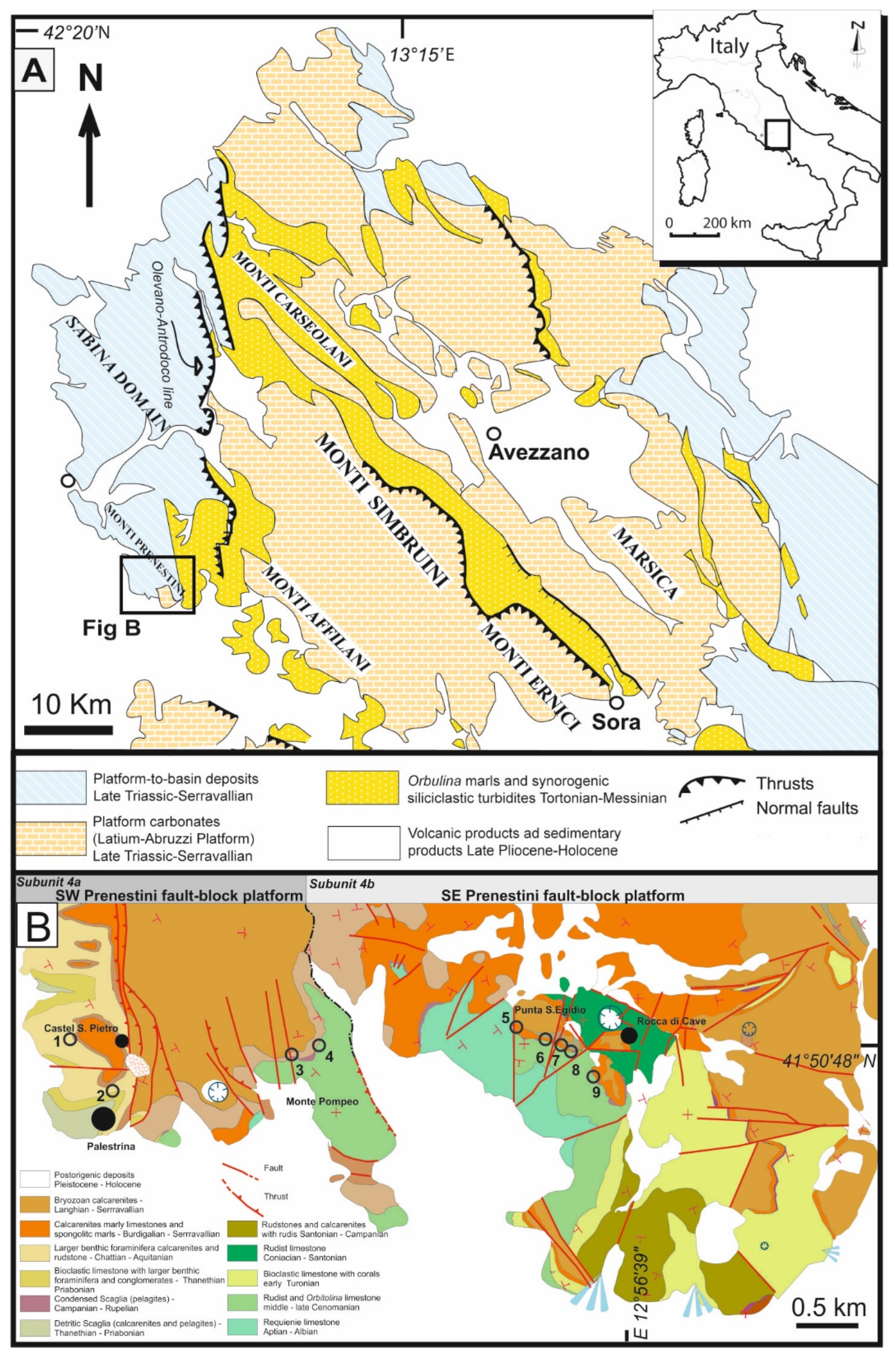
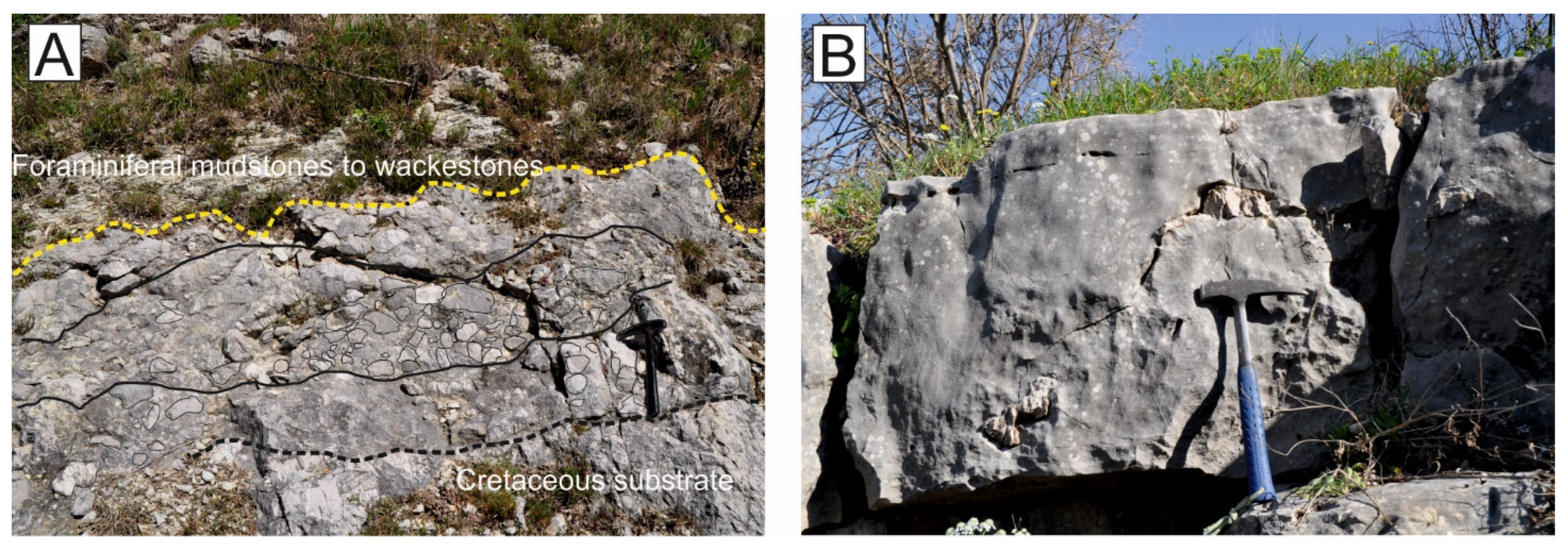
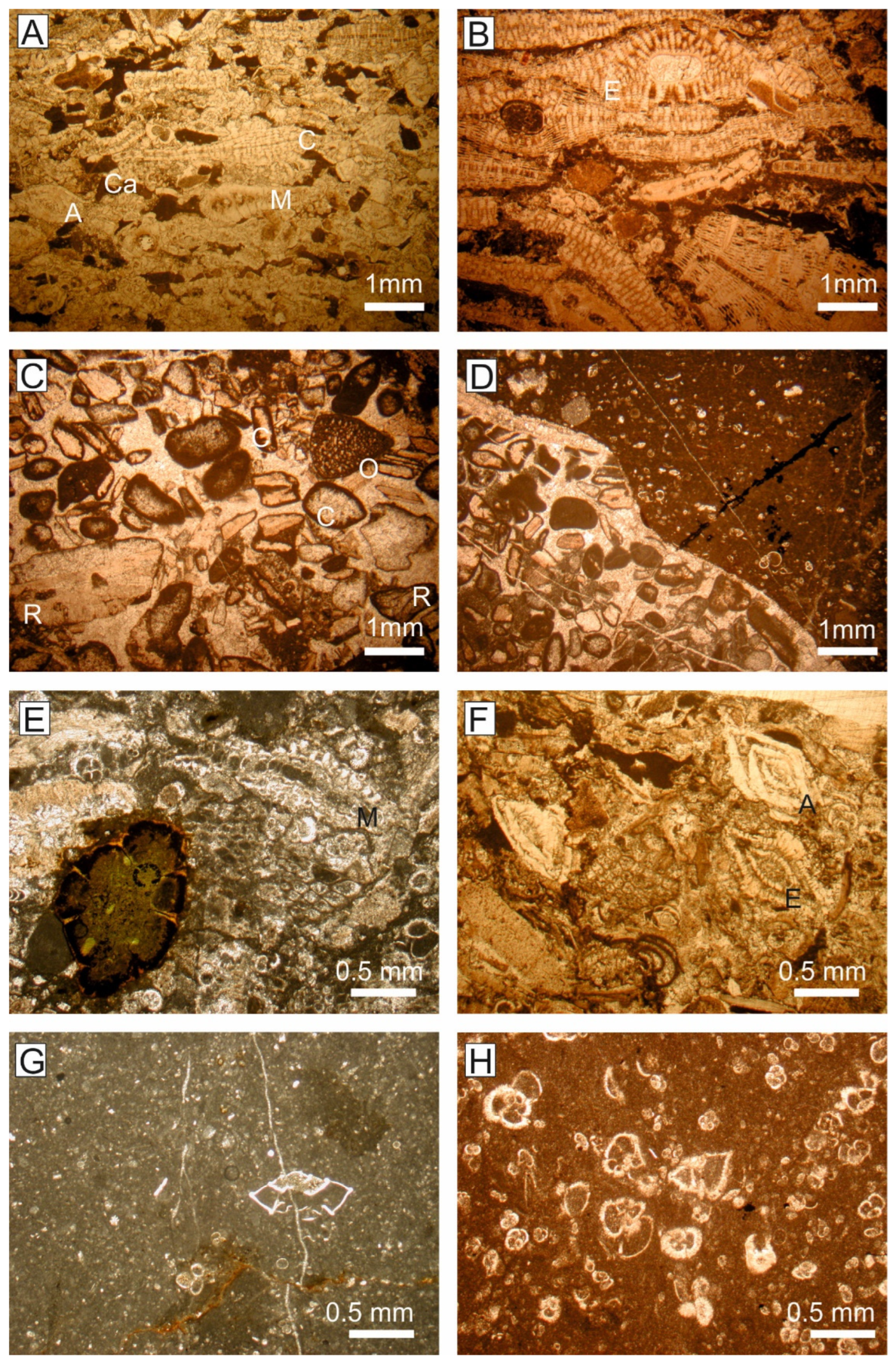

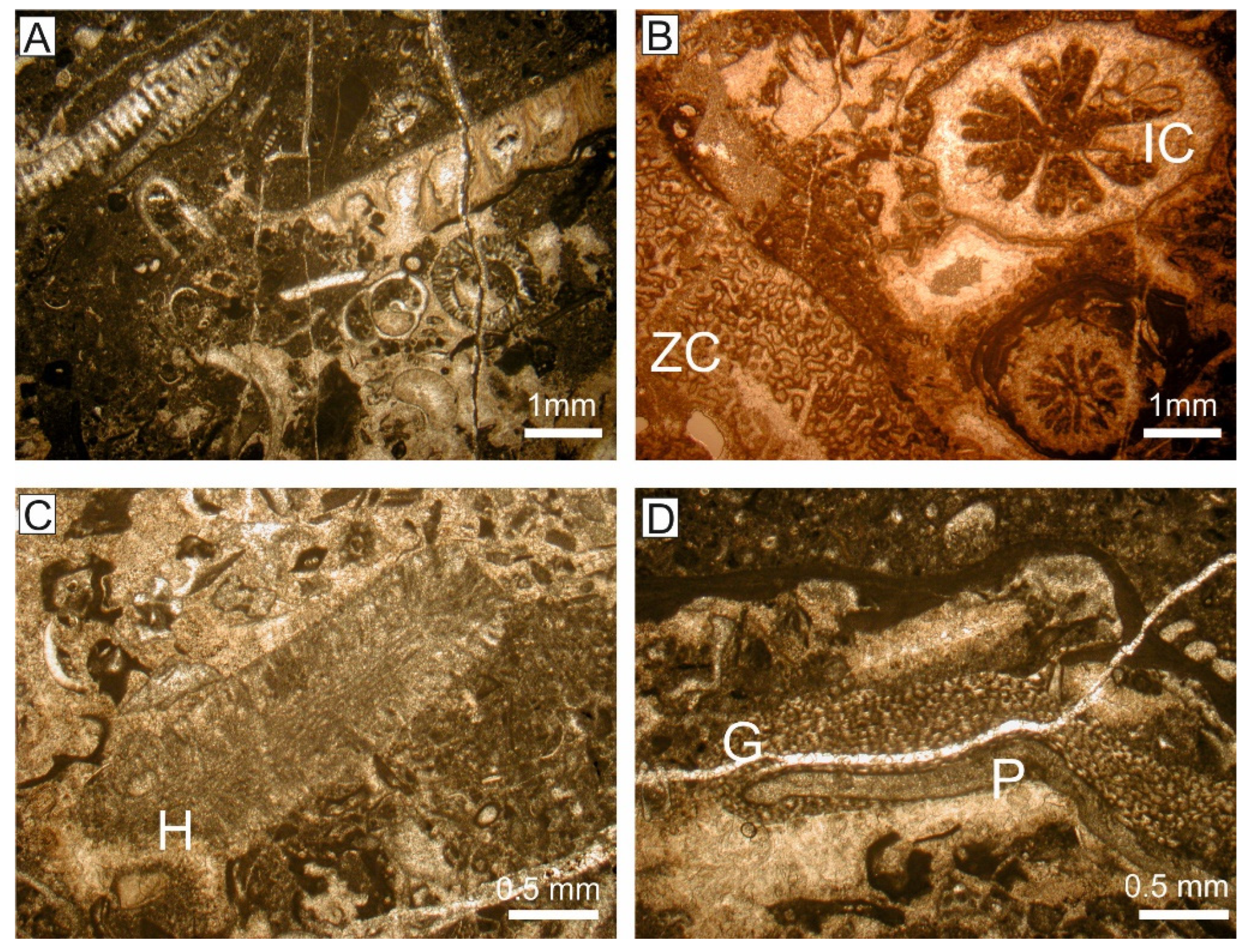
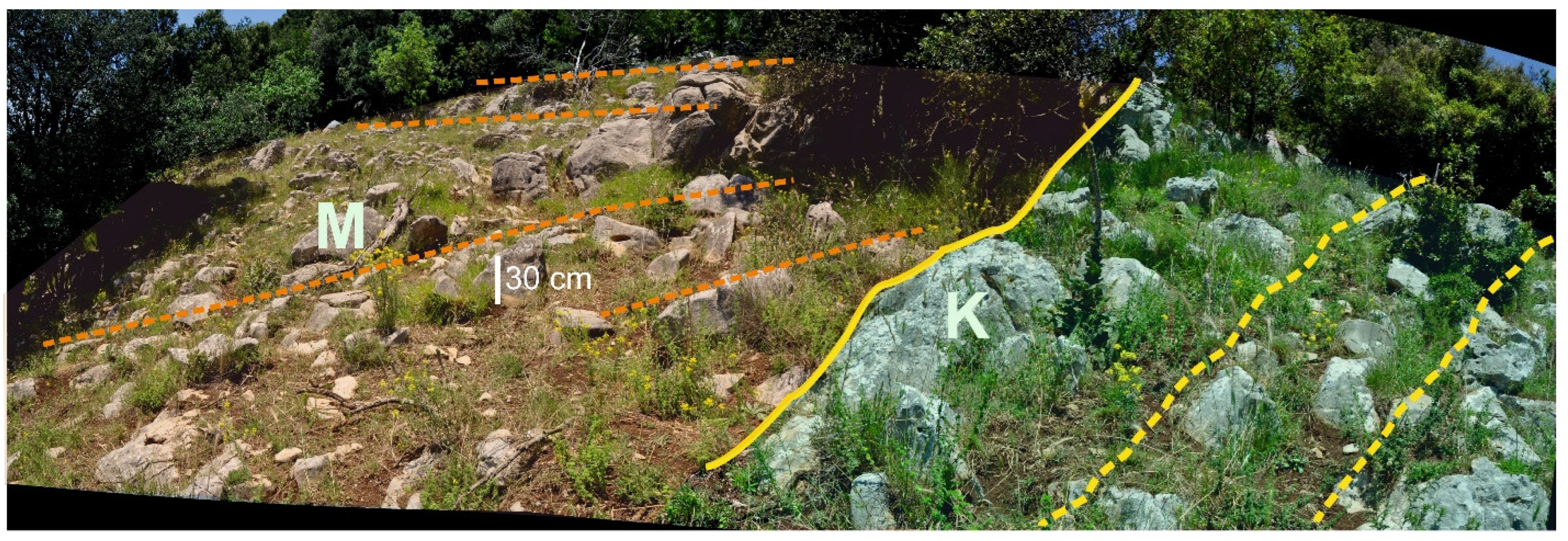
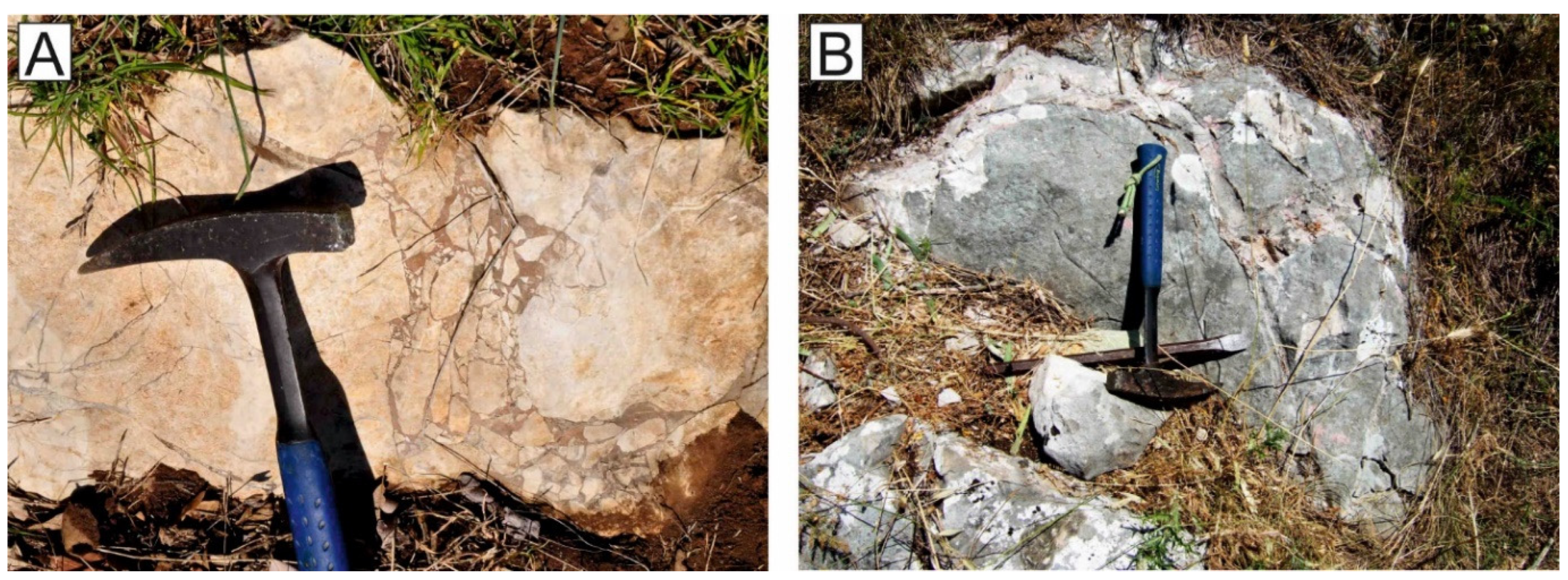
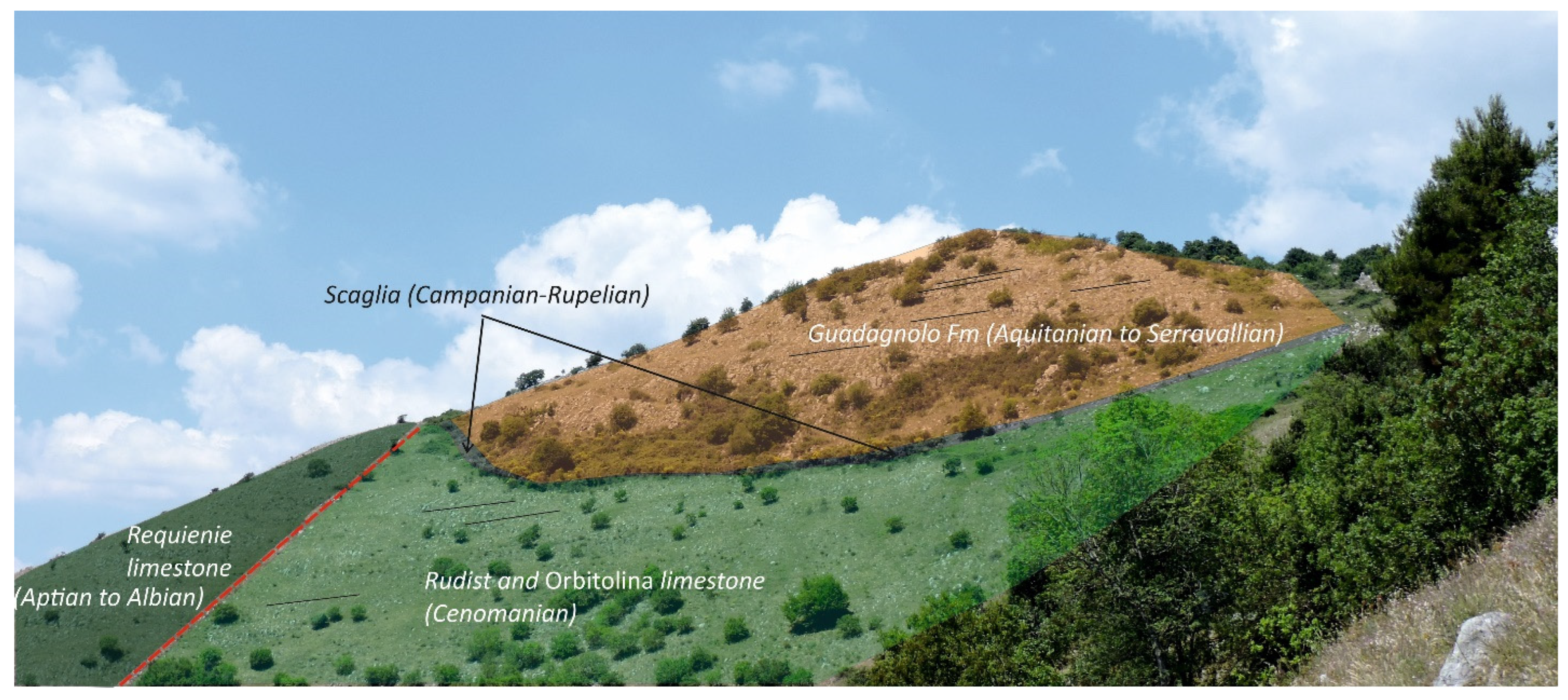
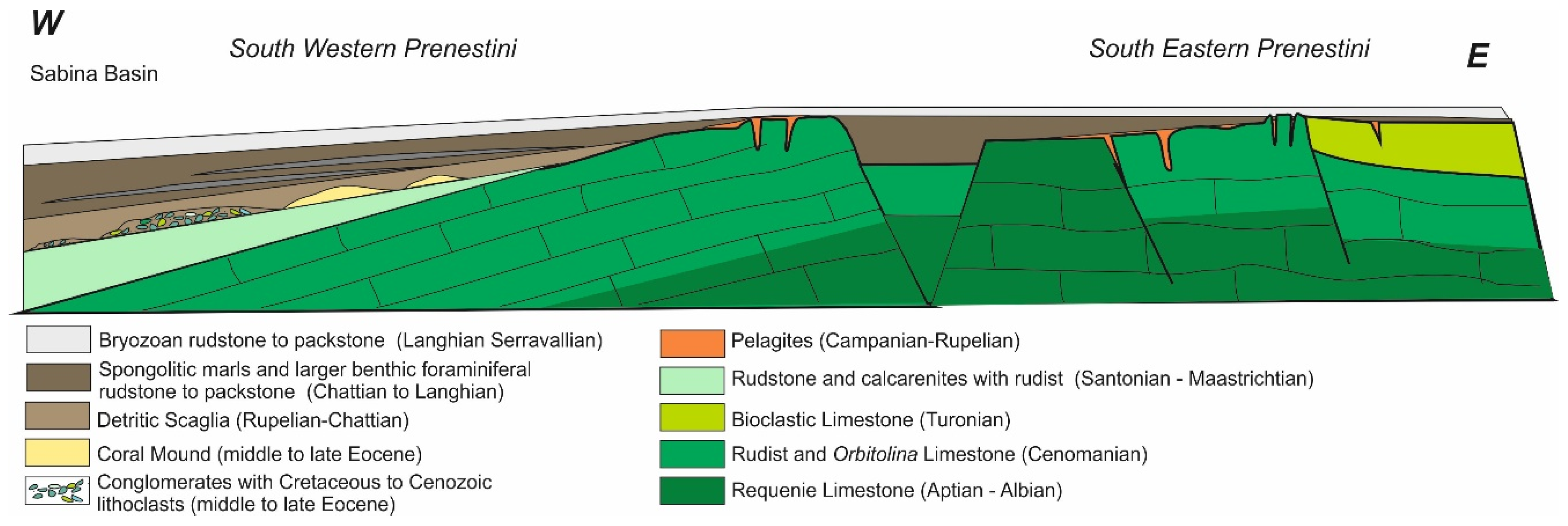

Publisher’s Note: MDPI stays neutral with regard to jurisdictional claims in published maps and institutional affiliations. |
© 2022 by the authors. Licensee MDPI, Basel, Switzerland. This article is an open access article distributed under the terms and conditions of the Creative Commons Attribution (CC BY) license (https://creativecommons.org/licenses/by/4.0/).
Share and Cite
Brandano, M.; Cornacchia, I.; Catanzariti, R. Fault-Block Platform Evolution between Late Cretaceous and Early Miocene along the Margin of the Latium-Abruzzi Carbonate Platform (Southern Prenestini Mountains, Central Apennines, Italy). Geosciences 2022, 12, 348. https://doi.org/10.3390/geosciences12090348
Brandano M, Cornacchia I, Catanzariti R. Fault-Block Platform Evolution between Late Cretaceous and Early Miocene along the Margin of the Latium-Abruzzi Carbonate Platform (Southern Prenestini Mountains, Central Apennines, Italy). Geosciences. 2022; 12(9):348. https://doi.org/10.3390/geosciences12090348
Chicago/Turabian StyleBrandano, Marco, Irene Cornacchia, and Rita Catanzariti. 2022. "Fault-Block Platform Evolution between Late Cretaceous and Early Miocene along the Margin of the Latium-Abruzzi Carbonate Platform (Southern Prenestini Mountains, Central Apennines, Italy)" Geosciences 12, no. 9: 348. https://doi.org/10.3390/geosciences12090348





